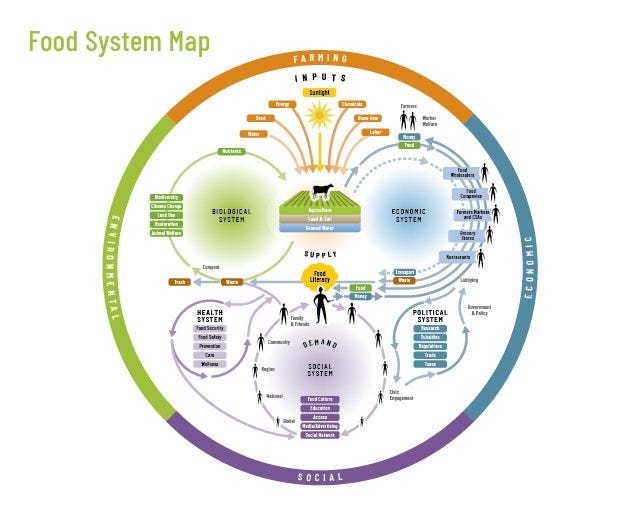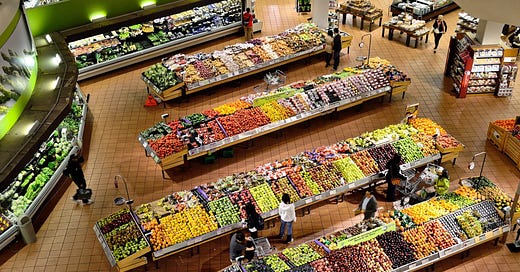Food apparently magically appears in a supermarket or a restaurant. How does it get there?
Simplistically we can say food came from the farm, was processed somehow, usually in a factory, and sent to retail for consumers to buy.
However, it isn’t that straightforward and in past few years we learned just how complicated our food system is.
What do I mean by a food system. There are many definitions with the best definitions from the Food and Agriculture Organization (FAO):
“Food systems (FS) encompass the entire range of actors and their interlinked value-adding activities involved in the production, aggregation, processing, distribution, consumption and disposal of food products that originate from agriculture, forestry or fisheries, and parts of the broader economic, societal and natural environments in which they are embedded1.”
And from Future of Food at Oxford University:
“The food system is a complex web of activities involving the production, processing, transport, and consumption. Issues concerning the food system include the governance and economics of food production, its sustainability, the degree to which we waste food, how food production affects the natural environment and the impact of food on individual and population health.2”
Thus, a food system is a non-linear network of inputs, outputs, and journeys our food travels including all the activities that take place to bring food to our plate. A food system considers the pre-farm and the post-plate such as effect on our health and/or the environment.
Not everyone agrees with these wide-ranging definitions. Per Pinstrup-Andersen3 argues that a broad definition like the two above makes it hard to differentiate between the food system and the whole economy and so recommends a narrow definition to avoid this confusion.
I disagree.
The food system is intertwined with the economic system and a change to one will affect the other. I don’t see any other way than changing our current capitalist market economy if we want food accessible to everyone.
Access to food is just one aspect of the food system as there are many influences on where, why, what and how we eat. Our family traditions, our personal values, the culture we come from, and the culture in which we live all work together to influence our personal food choices. Additionally, government policies and regulations impact our individual food system.
A food system approach models all the ways food gets to the table allowing us to see the complexity of the many components which interact at different levels of scale.
The components of the food system are important but it is the relationship between them that makes a food system a system. Their interaction at many different levels and layers makes it challenging for policy makers to make changes as the interconnecting dynamics may cause unexpected changes elsewhere in the system. For example, the Covid-19 pandemic leading to labor shortages and food and farmworkers standing up for their rights was not something that could have been predicted even in March 2020 at the beginning of the pandemic.

An additional complexity of the food system is the presence of other systems that exist within the food system, For example, the agricultural system and the distribution systems are studied in their own right as well as part of the larger food system. Farmers may be concerned about how to grow their crops sustainably. However, they might not consider the public health effects of what they are growing.
What are some of the questions we must to ask so we can strengthen the food system to make it safe, resilient, sustainable, equitable and healthy? For example, we might be interested in crop growth, the economic policies, or the psychology behind an individual’s food choices. Some of these questions and answers arrive if we look at the food system as a whole and recognize its complexity.
Hopefully, now you have read this brief introduction, you are interested in learning more about our food system and the different paths food takes to get to our plate.
To learn more about food systems, perhaps read Neff4 or with children use the John Hopkins Center for a Livable Future Food System curriculum5 and/or the Nourish Food System curriculum6.
Don’t forget to celebrate your food and enjoy every mouthful7.
If you want to chat more about how food science affects our food system, feel free to book a call - I love talking about food.
https://www.fao.org/3/ca2079en/CA2079EN.pdf
https://www.futureoffood.ox.ac.uk/what-food-system
https://foodsystems.blog/2021/04/29/what-is-a-food-system/
Neff, R (2015) Introduction to the U.S. Food System Wiley & Sons
https://www.foodspan.org/
https://www.nourishlife.org/teach/curriculum/
https://foodsafetymidatlantic.com/2019/05/food-is-joy/




